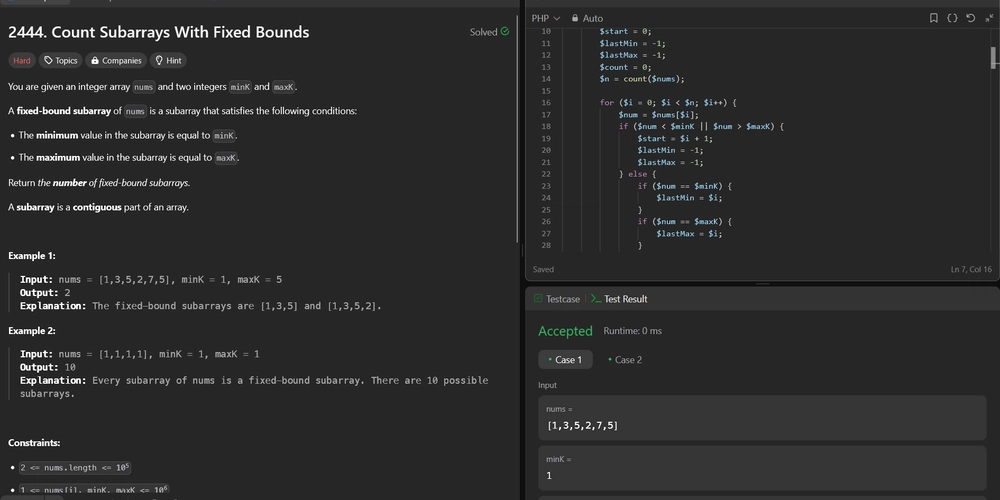2444. Count Subarrays With Fixed Bounds
2444. Count Subarrays With Fixed Bounds Difficulty: Hard Topics: Array, Queue, Sliding Window, Monotonic Queue You are given an integer array nums and two integers minK and maxK. A fixed-bound subarray of nums is a subarray that satisfies the following conditions: The minimum value in the subarray is equal to minK. The maximum value in the subarray is equal to maxK. Return the number of fixed-bound subarrays. A subarray is a contiguous part of an array. Example 1: Input: nums = [1,3,5,2,7,5], minK = 1, maxK = 5 Output: 2 Explanation: The fixed-bound subarrays are [1,3,5] and [1,3,5,2]. Example 2: Input: nums = [1,1,1,1], minK = 1, maxK = 1 Output: 10 Explanation: Every subarray of nums is a fixed-bound subarray. There are 10 possible subarrays. Constraints: 2

2444. Count Subarrays With Fixed Bounds
Difficulty: Hard
Topics: Array, Queue, Sliding Window, Monotonic Queue
You are given an integer array nums and two integers minK and maxK.
A fixed-bound subarray of nums is a subarray that satisfies the following conditions:
- The minimum value in the subarray is equal to
minK. - The maximum value in the subarray is equal to
maxK.
Return the number of fixed-bound subarrays.
A subarray is a contiguous part of an array.
Example 1:
- Input: nums = [1,3,5,2,7,5], minK = 1, maxK = 5
- Output: 2
- Explanation: The fixed-bound subarrays are [1,3,5] and [1,3,5,2].
Example 2:
- Input: nums = [1,1,1,1], minK = 1, maxK = 1
- Output: 10
- Explanation: Every subarray of nums is a fixed-bound subarray. There are 10 possible subarrays.
Constraints:
2 <= nums.length <= 1051 <= nums[i], minK, maxK <= 106
Hint:
- Can you solve the problem if all the numbers in the array were between minK and maxK inclusive?
- Think of the inclusion-exclusion principle.
- Divide the array into multiple subarrays such that each number in each subarray is between minK and maxK inclusive, solve the previous problem for each subarray, and sum all the answers.
Solution:
We need to count the number of subarrays where the minimum value is exactly minK and the maximum value is exactly maxK. These subarrays must be contiguous and all elements within them must lie between minK and maxK inclusive.
Approach
-
Sliding Window Technique: We maintain a sliding window where all elements are within the bounds
[minK, maxK]. If an element outside these bounds is encountered, the window is reset starting from the next element. -
Track Last Occurrences: For each position in the array, we keep track of the last positions where
minKandmaxKwere encountered. This helps in determining the valid subarrays ending at each position. -
Count Valid Subarrays: For each valid window, if both
minKandmaxKhave been encountered, the number of valid subarrays ending at the current position is determined by the earliest occurrence of eitherminKormaxKwithin the window.
Let's implement this solution in PHP: 2444. Count Subarrays With Fixed Bounds
/**
* @param Integer[] $nums
* @param Integer $minK
* @param Integer $maxK
* @return Integer
*/
function countSubarrays($nums, $minK, $maxK) {
...
...
...
/**
* go to ./solution.php
*/
}
// Example 1
$nums = array(1, 3, 5, 2, 7, 5);
$minK = 1;
$maxK = 5;
echo countSubarrays($nums, $minK, $maxK) . "\n"; // Output: 2
// Example 2
$nums = array(1, 1, 1, 1);
$minK = 1;
$maxK = 1;
echo countSubarrays($nums, $minK, $maxK) . "\n"; // Output: 10
?>
Explanation:
-
Sliding Window Initialization: We initialize
startto 0, which marks the beginning of the current valid window.lastMinandlastMaxtrack the last positions ofminKandmaxK, respectively. -
Iterate Through Array: For each element in the array, check if it lies within the bounds
[minK, maxK]. If not, reset the window starting from the next element and reset the last positions. -
Update Last Positions: If the current element is
minKormaxK, update the respective last occurrence positions. -
Count Valid Subarrays: If both
minKandmaxKhave been encountered in the current window, calculate the number of valid subarrays ending at the current position. This is determined by the earliest of the last occurrences ofminKormaxKrelative to the start of the window.
This approach efficiently counts the valid subarrays in linear time, ensuring optimal performance even for large input sizes.
Contact Links
If you found this series helpful, please consider giving the repository a star on GitHub or sharing the post on your favorite social networks































































































































































![[The AI Show Episode 143]: ChatGPT Revenue Surge, New AGI Timelines, Amazon’s AI Agent, Claude for Education, Model Context Protocol & LLMs Pass the Turing Test](https://www.marketingaiinstitute.com/hubfs/ep%20143%20cover.png)



























































































































![[FREE EBOOKS] AI and Business Rule Engines for Excel Power Users, Machine Learning Hero & Four More Best Selling Titles](https://www.javacodegeeks.com/wp-content/uploads/2012/12/jcg-logo.jpg)










































































































































































































































![Hostinger Horizons lets you effortlessly turn ideas into web apps without coding [10% off]](https://i0.wp.com/9to5mac.com/wp-content/uploads/sites/6/2025/04/IMG_1551.png?resize=1200%2C628&quality=82&strip=all&ssl=1)




![This new Google TV streaming dongle looks just like a Chromecast [Gallery]](https://i0.wp.com/9to5google.com/wp-content/uploads/sites/4/2025/04/thomson-cast-150-google-tv-1.jpg?resize=1200%2C628&quality=82&strip=all&ssl=1)












![Apple Drops New Immersive Adventure Episode for Vision Pro: 'Hill Climb' [Video]](https://www.iclarified.com/images/news/97133/97133/97133-640.jpg)

![Most iPhones Sold in the U.S. Will Be Made in India by 2026 [Report]](https://www.iclarified.com/images/news/97130/97130/97130-640.jpg)




































































































































